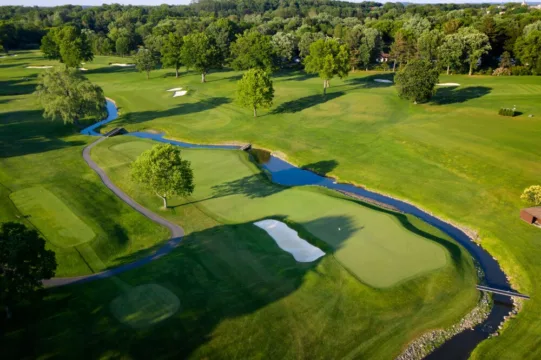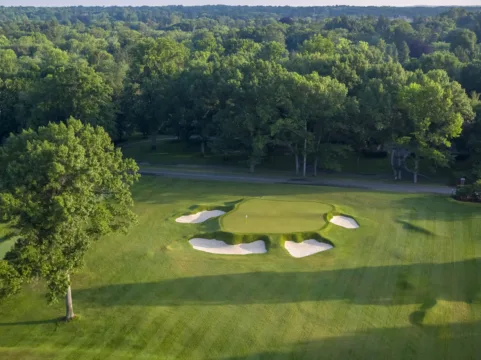
PITTSFORD, NY – I had to endure quite a few incendiary comments from my upstate New York golf friends back in 2013 when they asked me to compare their beloved Oak Hill to other major championship venues.
They did not like hearing that I preferred a long list of courses –- Oakmont, Winged Foot, Pebble Beach and the like -– that were stronger, more interesting golf courses than Oak Hill East -- Donald Ross pedigree or no. They did not want to harken to my arguments: Trees were choking the fairways, it surrendered several record low scores in its history, and the holes tended to be repetitive, especially after redesigns by Robert Trent Jones, Sr. in the 1950s and by George and Tom Fazio in the 1970s and '80s traded strategic architecture for penal.
And they let me hear it!
But now that the Second Golden Age of Golf Course Architecture has finally arrived in upstate New York, now that renovation architect Andrew Green has brought Oak Hill into the 21st century, all those cries of “You can’t possibly be right!” have turned to “Well of course he’s right!”
Happily, the competitors at the 105th PGA Championship -- and the fourth to be contested over Oak Hill’s East Course (along with three U.S. Opens, one unforgettable Ryder Cup in 1995 and the 1949 U.S. Amateur) -- agree. It seems a unanimous opinion that the combination restoration and renovation is a smashing success. It made the course more difficult, yet opened up many more playing options for the golfers. It updated the hazards, and it recovered lost pin placements on the greens. And the new holes are a super-sized improvement over the holes redesigned by intervening architects in previous decades.
“It’s certainly a lot different than the course we played for the 2013 championship. I think Andrew Green has done a phenomenal job,” said 2011 and 2014 PGA champion Rory McIlroy.
"I guess sort of restoring it back to probably the way Donald Ross wanted the golf course to play and to set up. I think he's done a great job there. I think that there's only been improvements to the golf course since the last time a big tournament was played here. What I've heard from most of the other guys that have played, there seems to be some really good reviews of it, so I'm excited to play it in a tournament and see how it holds up. This golf course historically has held up very well, so I'm expecting no different this week.”

McIlroy followed those observations with praise for the expanded putting surfaces, which recaptured many corner hole locations, made more difficult by deeper bunkers guarding them, with steeper faces. Staying out of the bunkers, he noted, was critical, as of course was driving accuracy.
“You've got to keep it out of those fairway bunkers,” McIlroy advised. “If someone can keep their discipline and not start firing at those pins and know that middles of the greens is a pretty good leave on most holes, I think that's…an advantage. But I think even more of an advantage is making sure that you're hitting into these greens from the fairways.”
“It will take discipline, I agree with Rory,” added newly-minted Masters champion Jon Rahm, who also won the 2021 U.S. Open at Torrey Pines.
“Tough course,” he intoned wide-eyed and with a note of respect. He added, “Whoever is setting up the golf course is going to have a lot of fun, because there's a lot of opportunities on holes with pin locations and tee boxes, so you can make this golf course as difficult as you want or not as accessible as you want, but obviously you can make a big difference in the scoring.”
Rahm also stressed accuracy, both of the tee and on the approach shots, fearing that otherwise the newly renovated and ferocious bunkers would wreak havoc on the scorecard, perhaps leading to a Friday exit.
“Ball striking will be at a premium. If you hit the shots you're supposed to hit -- put it in the fairway, go to the center of the green -- nothing crazy should be happening,” he surmised, and rather obviously. No sane golfer could argue with that. "But if you don’t... some of the holes that are quite narrow; those bunkers are no joke. It's never going to stay on the up slope. It always goes down to the flat, and it's always some severe slopes. You're most like going to be short-sided.”
Rahm then highlighted the dichotomy between the new shaved chipping areas on the one hand and the thick rough on the other; it’s pick your poison.
“You have those runoffs everywhere on a lot of the greens where you can hit a really good shot that basically goes 10 feet off the pin, and next thing you know you have 30 yards with big slopes. Those fairways are very well manicured. They're very fast. It's not the easiest shot to hit. And then you have the other side of the corner. It's thick rough where you depend a lot on the lie,” Rahm lamented.
But then he brightened, recalling how past major champions used their short game prowess to rise above the crowd, something the new Oak Hill East Course’s green complexes should test to the utmost.
“Everybody will miss fairways; everybody will miss greens. So if you can get those up-and-downs, obviously it's not only a confidence booster, but it's something that will keep the round going,” Rahm concluded.
Finally, thousands upon thousands of trees have come down. Justin Thomas worries that on a windless day, Oak Hill east could become a bomber’s paradise, but that’s not true of The Country Club, which staged such a wildly successful U.S. Open last year, nor of Oakmont, which set the standard for tree removal and ignited the movement nationwide.
Better still, how many great golf courses are now in high renaissance with improved drainage and turf conditions, not to mention that one look across the newly-recovered long vistas across the property will inspire golfers to grab their clubs and race to the tee box? And now the movement back to harmony – the Second Golden Age of Golf Course Architecture – has come to upstate New York, a cradle of American golf-course architecture in its formative years. Call it “How to Turn Around a Hater in One Easy Lesson” or “How Upstate New York learned to Stop Worrying and Cut the Stupid Trees Down, Dammit.”
As a result, finally, nearby Golden age masterpieces Yahnundasis Golf Club in Utica and Teugega Golf Club in Rome are undergoing stupendous restorations/renovations by young lion architect Jaeger Kovach and wily veteran architect Ron Forse, respectively. The pros may get to play Oak Hill this weekend, but the cutting edge of the craft has arrived throughout the region, to the delight of rank and file players everywhere.

